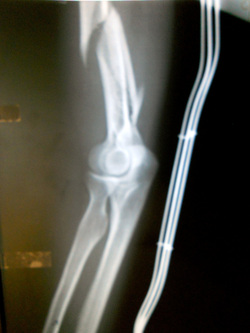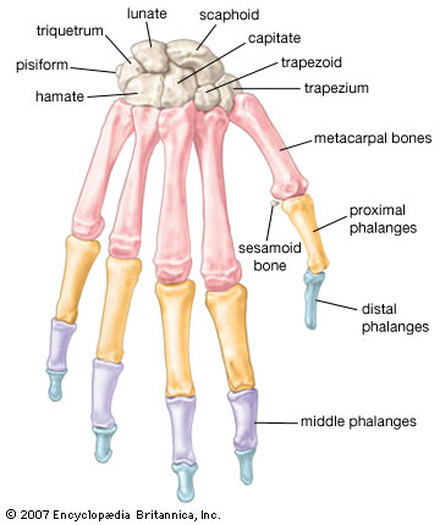The Upper Extremities

There are three parts to each upper extremity (left and right). They are: the arm, the forearm, and the hand.
Arm
The arm, also called the brachium, is the area between the shoulder and elbow. It consists of a single bone, the humerus. The humerus is the largest bone in the upper extremities. The rounded top of the humerus fits into the scapula in the shoulder girdle. The bottom portion of the humerous has two indentions where it connects to the radius and the ulna. The radius connects to the humerus on the side farthest from the body while the ulna connects to the humerus on the side closest to the body. The humerus, together with the ulna, forms the elbow.
Forearm
The forearm is the area between the elbow and the wrist. It is made up of two bones: the radius (side farthest from the body) and the ulna (side closest to the body). The ulna is the longer of the two bones, and, together with the humerus, forms the elbow. The radius contributes to movement in the wrist.
Hand
The hand is made up of 27 different bones that are divided into three categories: carpus (wrist), metacarpus (palm), and phalanges (fingers). The wrist is made up of eight carpal bones that are connected to one another by ligaments. The palm is made up of five metacarpal bones that are numbered I-V, beginning at the thumb. The metacarpals connect to the carpals, and to the fingers of the bones. The fingers are made up of 14 bones (phalanges). Below is a diagram that shows the placement of all 27 bones in the wrist and hand.
Arm
The arm, also called the brachium, is the area between the shoulder and elbow. It consists of a single bone, the humerus. The humerus is the largest bone in the upper extremities. The rounded top of the humerus fits into the scapula in the shoulder girdle. The bottom portion of the humerous has two indentions where it connects to the radius and the ulna. The radius connects to the humerus on the side farthest from the body while the ulna connects to the humerus on the side closest to the body. The humerus, together with the ulna, forms the elbow.
Forearm
The forearm is the area between the elbow and the wrist. It is made up of two bones: the radius (side farthest from the body) and the ulna (side closest to the body). The ulna is the longer of the two bones, and, together with the humerus, forms the elbow. The radius contributes to movement in the wrist.
Hand
The hand is made up of 27 different bones that are divided into three categories: carpus (wrist), metacarpus (palm), and phalanges (fingers). The wrist is made up of eight carpal bones that are connected to one another by ligaments. The palm is made up of five metacarpal bones that are numbered I-V, beginning at the thumb. The metacarpals connect to the carpals, and to the fingers of the bones. The fingers are made up of 14 bones (phalanges). Below is a diagram that shows the placement of all 27 bones in the wrist and hand.

